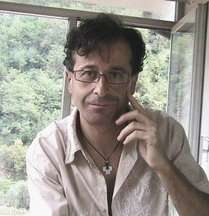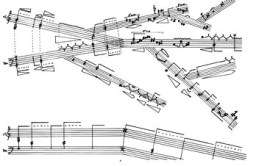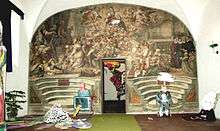Sergio Maltagliati
Sergio Maltagliati (born 1960 in Pescia, Italy) is an Italian Internet-based artist, composer, and visual-digital artist.[1] His first musical experiences with the Gialdino Gialdini Musical Band in early 70s.

Biography
Sergio Maltagliati an artist from Florence Italy; studied music at the Conservatory "Luigi Cherubini" in Florence,[2] then he began to paint. Thus creating a new method of writing music where the score becomes a visual composition. The relation between the sound and color creates a living feeling that art is not dead. It does not stop at the artist's last attempt at the canvas, but goes beyond to the viewer. It is the relationship between artist and viewer, one is no different from the other. Now the viewer can take the step that the artist may dare not to across. It is the point of translation a fear to most artist that want to create and let their work go. This kind of art allows the viewer to create with the artist and create so much more. Sergio Maltagliati has always been deeply interested in a multimedia concept of art.[3] His education, in both music and the visual arts, has placed him in the position to incorporate sign, colour, and sound into a unitary concept of multiple perception, through analogies, contrasts, stratifications, and associations. At present he is a teacher professor.
He's a composer who joined, at the end of the eighties, the Florentine artistic current, that has been active since the end of World War II up to the present, including Sylvano Bussotti, Giuseppe Chiari, Giancarlo Cardini, Albert Mayr, Daniele Lombardi, Pietro Grossi. These musicians have experimented the interaction among sound, sign and vision, a synaesthetics of art derived from historical avant-gardes, from Kandinskij to futurism, to Scrjabin and Schoenberg, all the way to Bauhaus.
His work in the eighties is also based in involving, with didactic-educational projects, students as executors of performances in the example of the Music Circus carried out in 1984 in a High School in Piemonte by John Cage. And it is the American musician (met in 1991 in Zurich for the execution of Europeras 1&2)[4] who appreciates this aspect of Maltagliati's work, because he is able to involve young people as performers. These works, besides building approach to music and, specifically, developing a different way of listening, aim at expanding the concept of artistic creation to the executor, till it reaches just the user, often unprovided with a traditional artistic formation.
Since 1997, Sergio Maltagliati has dealt principally in music on the Internet and one of his first compositions intended for the network, netOper@[5] a new, and the first Italian interactive work for the Web starting in the spring of 1997.[6] The interactive work will be presented simultaneously in real and cyberspace. The Opera is realized with the collaboration of Pietro Grossi, the legendary father of Italian music informatics.[7] The essential aspect to Sergio Maltagliati's approach is the idea that art is not just the fruit of the composer, the creation is always the fruit of collaboration. Two of his works are strongly based on this concept: neXtOper@_1.03 (2001)[8] a work for mobile phones, and midi_Visu@lMusiC (2005) music and images on I-Mode mobile phone. In 1999, he writes the program autom@tedVisualMusiC,[9] software from experiences of the visual HomeArt programs designed by Grossi in the '80s, written in the language BBC Basic with computer Acorn Archimedes A310, a project that creates abstract designs and sound by using programming to make the piece interactive and adds movement. This artwork not only has visually pieces, but also is interactive.[10] In 2001, he has participated in the project Interview yourself by Amy Alexander.[11]
He currently uses a personal computer to set up interactive sound and graphics works, open compositions where the listener has a predominant and decisive role.
Instrumental compositions

- 1980 Fogli di Diario lyric for mezzo-soprano-flute and piano (first performance - Belveglio Asti 1980).
- 1983 Iridem for trombone and clarinet.
- 1984 Inciclo for trombone solo.
- 1987 La Luce dell'Asia for white voices choir.
- 1980/89 Sintassi in Rosso e Nero for voice and piano (first performance -Villa Martini Monsummano Terme 1989).
- 1991 Sinfonia (first performance 1991).
- 1993 Aria48 for canto and orchestra.
Computer Visu@lMusiC

autom@tedVisualMusic, generative visualmusic software, creates images and sounds in relation to precise correspondences sound-symbol-color, producing multiple variations.[12]
Works
- 1999 Circus 5.05 (from original BBC Basic graphics software, music software autom@tedMusic 1.01).
- 2001 Net Surfing 3.0 (icons, and casual sounds from the Web, arranged and reorganized with reference to precise correspondences among sound/colour/image).
- Autom@ted Music 1.02
- Sound Life 3.01 (computer music transcription by Pietro Grossi-Soft TAUMUS synthesizer TAU2, IBM 370/168- Institutes of CNR CNUCE and IEI Pisa, Italy 1980)
- 2002 PIxeLs
- Oper@pixel (the traditional Lyric Opera, an unusual presence in its new digital guise).
- 2003 Goldberg Variations (music by Johann Sebastian Bach).
- 2005 MIDI_Visu@lMusiC (from music software Steinberg Cubase on Atari Mega STE - free download Music/Ringtones).
- 2008 Circus4/8
- 2012 autom@tedVisuaL, is a software which generates always different graphical variations. It is based on HomeArt’s Q.Basic source code. These graphics are going to be sammled into the HomeBooks (also available as e-books), a unique kind of book, which Pietro Grossi planned in 1991. This first release autom@tedVisuaL 1.0 has produced 45 graphical single samples, which have been sammled and published.
- 2014 autom@tedMusiC 2.0, generative music software. This program can be configured to create music in many different styles and it will generate a new and original composition each time play is clicked.
Performance
- 1985 Musica intorno alla Gabbia (Music around the Cage- homage to John Cage) for music, art of mime and zoo-anthropomorphous pictures with 170 performers-actors (first performance Ospedale degli Innocenti Florence 1985). In the structure of the work, the traditional role between audience and stage has been reversed on purpose. The interpreters have occupied, geometrically, the vast space of the room putting the public first on the stage and causing them, then, to move around the sound and visual groups. The musical part is based on the interdisciplinary value of music, inspired by John Cage's research on the principle of "capturing and controlling the noises as musical elements". The choreographic and scenic part of the work, made by painter Edoardo Salvi was an uninterrupted dynamism of forms and spatial situations, connecting image to signs and sound.
 Music around the Cage Innocenti Hospital -scenography-(Florence 1985)
Music around the Cage Innocenti Hospital -scenography-(Florence 1985) - 1989 Revolution The visual part of the work is composed of a big painting, of about three hundred square metres, on which two hundred high school students have worked. The painting, divided into sixteen big strips, came together slowly, in synchronization with the music during the performance. The musical part assembled four different sound situations: instrumental music, words, sounds and noises.
- 1990/91 K.1-626M. for chorus, orchestra, magnetic tape, and objects (first performance Manzoni Theatre Pistoia Italy 1990).
- 1993 12 free improvisations with stones and branches of river (first performance – Villa Martini Monsummano Terme Italy 1993).
- Alla ricerca dei Silenzi perduti for 10 magnetic tapes, 7/10 audio tape with 10 performers.
- 1997 Netoper@ an Italian opera with an international cast of performers on the Net, authors and performers of the work more than thirty (net)artists.
- Variazione Cromatica cinque2 for instruments and Magnetic tape.
- Invenzioni Cromatiche 16/44 graphic work music of 100 children on musical stroke of 16/4.
- 2001 NeXtOper@ for cell.phones, interactive/collaborative work through Internet and GSM networks (cellular phones) with an educational project involving the children of Middle State School "Giusti-Gramsci" Monsummano Terme Italy.[13]
Exhibitions
- International exhibitions include: HyperArt Web Gallery (New York);[14] Istanbul Contemporary Art Museum;[15] Rhizome.org; Digital Pocket Gallery (Helsinki); PEAM Festival (Pescara); DigitalSoul San Francisco (USA); Melbourne Fringe Festival; Festival Carnivale Town Hall (Sydney); Electronic Language Festival (San Paolo del Brasile);[16] Politecnico di Milano University (Italy); Salons de Musique Strasbourg (France); Sound Art Museum (Rome);[17] Museum of Contemporary Art Mérida Yucatán (Mexico); MAXXI - National Museum of the 21st Century Arts (Rome); Galerie De Meerse Hoofddorp (Amsterdam); Italian Cultural Institute (Cairo); PAN (palace arts Naples Italy); Museo della Civiltà Romana - Rome (Italy); Art Laboratory Berlin; Centro per l'Arte Contemporanea Luigi Pecci - Prato (Italy).
Bibliography
- Encyclopedia of New Media Art by Joe Street ed. Orange Apple - ISBN 978-1-283-48829-7 (2016) (in English)
- 80 identikit digitali by Carlo Mazzucchelli ed. Delos Digital - ISBN 9788867756414 (2015) (in Italian)
- Enore Zaffiri-Saggi e materiali by Andrea Valle & Stefano Bassanese ISBN 9788890341328 (2014) (in Italian) (in English)
- Topología Barcelona, Athens. Triton Barcelona. Triton ISBN 978-84-938482-5-5 (Triton Barcelona) ISBN 3-85486-212-1 (2014)
- HomeBook 45 unicum graphics, by Pietro Grossi, Sergio Maltagliati, ed. Lulu.com, 2012. ISBN 978-1-4716-1419-4 (in English) (in Italian)
- Random Valentina Tanni, LINK Editions, Brescia 2011- ISBN 978-1-4477-1182-7 (in Italian)
- Sguardi Sonori/Infinite Spaces, by Ennio Morricone, Enrico Saggese, Roberto Vittori, Neil Leonard, Gualtiero Marchesi, (2010) ed.Municipality of Rome (in Italian) (in English)
- Generative Art, by Celestino Soddu, Enrica Colabella, (2009) ed. Domus Argenia Publisher. (in English)
- Il Senso Trascurato, by Luigi Agostini, (2009) Edizioni Lulu.com (in Italian)
- Netspace: viaggio nell'arte della rete - Net Archives by Elena Giulia Rossi, (2009) Roma, ed. MAXXI Museo Nazionale delle Arti del XXI secolo.
- Attraversamenti, la musica in Toscana dal 1945 ad oggi, by Daniele Lombardi, Firenze 2009, Regione Toscana, Consiglio Regionale, Edizioni dell’Assemblea.
- Arte delle reti / Net Art - Elementi per un atlante: liste e linee temporali (2007) Edizioni UCAN - BOOK001 (in Italian)
- AD LIBITUM. Musica da vedere, by N.Cisternino, I.Gómez, F.Mariani e M.Ratti, (2003) SilvanaEditoriale (in Italian)
- Information Arts, Stephen Wilson, (2003) MIT Press ISBN 0-262-73158-4 (in English)
- Attraversamenti by Daniele Lombardi: La musica in Toscana dal 1945 ad oggi 2002 (Firenze, Maschetto&Musolino) (in Italian)
- Partiture Assessorato alla Cultura Comune Montecatini terme (1991) CID/Arti Visive Centro Luigi Pecci Prato (in Italian)
CD / DVD
- Suono Segno Gesto Visione a Firenze 2 P.Grossi, G.Chiari, G.Cardini, A.Mayr, D.Lombardi, M.Aitiani, S.Maltagliati (Atopos music)
- CIRCUS_8 DVD video Quantum Bit Limited Edition / QuBIT 005 (in English)
- The Wave Structure of Matter Quantum Bit Netlabel / QuBIT 007 (in English)
- CIRCUS_5.1 DVD (digital edition) Quantum Bit Netlabel / QuBIT 013 (in English)
Audio Tape
- 1992 Trasparenze
- 1993 Alla ricerca dei silenzi perduti
- 1995 Serie di colore per flauti
- 1996 Per una sola nota
- 1997 Partiture per floppy disk
Recorder from original tape Quantum Bit Limited Edition
References
- ↑ "Wikiartpedia (IT)". 2005.
- ↑ "AND - Artists Network Database". 2007.
- ↑ Valentina Tanni (2001). "oper@PiXeL".
- ↑ "letter written by John Cage". 2010.
- ↑ Ted Warnell (1999). "THE NET OPERA". Zn new media library.
- ↑ Manuela Misani (2004). "Italian Digital Art Overview 2004(.doc)".
- ↑ Luca Cartolari (2008). "NetOpere: Pietro Grossi and Sergio Maltagliati".
- ↑ "neXtOper@". Art in Mobile. 2008.
- ↑ MAXXI - National Museum of the 21st Century Arts (2007). "Improvisations of the Software".
- ↑ "Yeditepe University, Istanbul, Turkey" (PDF). 2003.
- ↑ Amy Alexander (2001). "Interview yourself".
- ↑ "Generative Art Politecnico of Milano University". 2001.
- ↑ "Middle State School Giusti-Gramsci". 2001.
- ↑ "Hyperart gallery New York City". 1999. Archived from the original on 2001-04-22.
- ↑ "Istanbul Contemporary Art Museum". 2002.
- ↑ "ELECTRONIC LANGUAGE INTERNATIONAL FESTIVAL". 2004. Archived from the original on 2011-09-29.
- ↑ "radioartemobile". 2007. Archived from the original on 2012-02-22.
External links
- Personal Site Visu@lMusiC (in Italian) (in English)
- HomeArt Images by Pietro Grossi (in English)
- Pietro Grossi (in Italian)